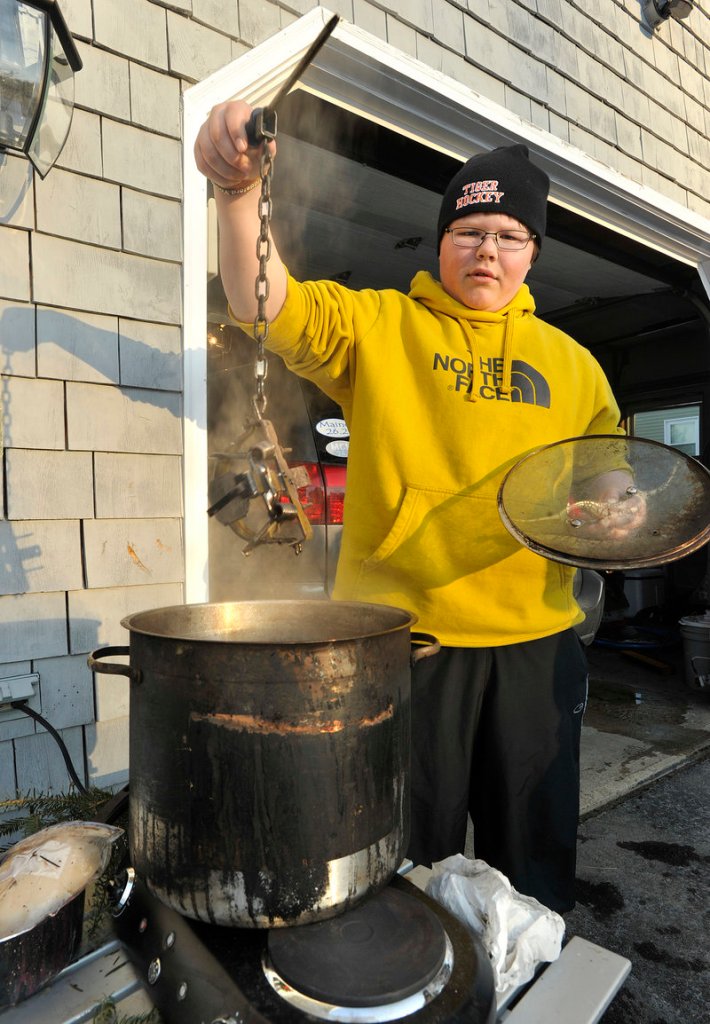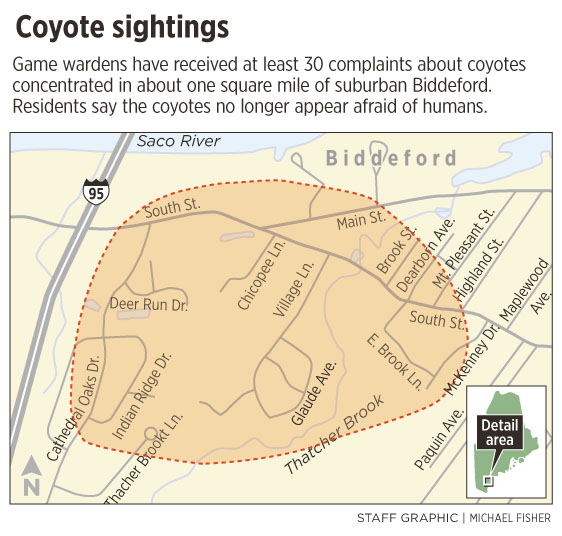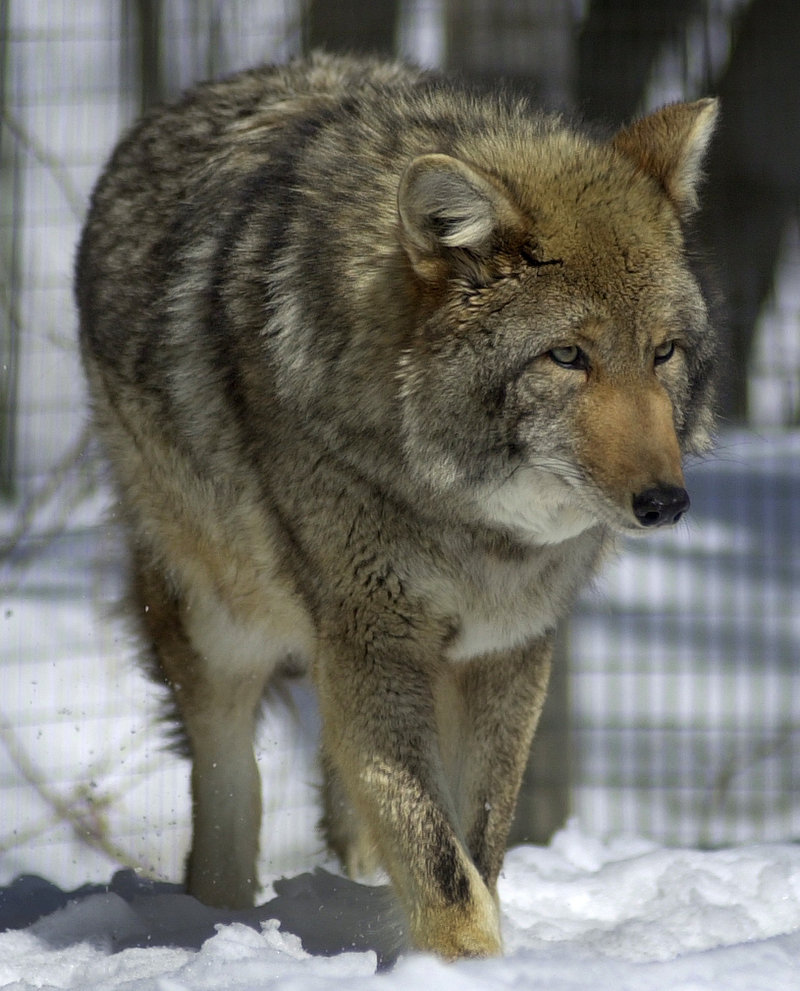BIDDEFORD — A few months ago, Alex Paul was surprised to see a coyote wander across the backyard of his home on East Brook Lane.
Within a couple of weeks, he would see three or four coyotes walking together through the suburban neighborhood, not far from Biddeford’s busy downtown.
Cats and a dog in the neighborhood disappeared, residents began keeping a close eye on young children playing outside, and coyotes were seen walking down the road, appearing unafraid of people.
“We’d see them at all hours of the day. We found that odd,” Paul said. “They seemed very bold and very comfortable around civilization.”
Game wardens have fielded at least 30 complaints from residents about the appearance of a family of coyotes in their densely populated neighborhoods, prompting state officials to consider having a state-licensed animal damage control agent shoot at least some of the coyotes.
The city has scheduled a meeting for 7 p.m. Thursday in the new lecture hall at Biddeford High School to update residents on the situation, dispel rumors about rabid coyotes and educate them about coyotes, said City Manager John Bubier.
The city also plans to work with a Maine-based conservation biologist to develop a coyote management plan, teach residents how to co-exist with the predators and educate people through public access television.
“The coyotes have been there for 25 to 30 years. What’s new is people are seeing them walk through the backyard,” Bubier said.
Coyotes are sometimes seen in urban and suburban areas, especially as development spreads into their territory. Even major cities like Los Angeles and Chicago have had problems with coyotes, which are highly adaptable and intelligent, say wildlife biologists.
Seeing coyotes in her neighborhood in Biddeford has been a little unnerving for Erin Behen of Village Lane. But it’s fascinating for her 14-year-old son, Thomas, an avid hunter.
Since he saw a coyote at the school bus stop one morning, Thomas Behen has spent hours researching coyotes and preparing to take a state course to become a licensed trapper. On Monday afternoon, he practiced preparing a coyote trap outside his house.
The Behen family started hearing coyotes in the neighborhood last summer.
“It would sound like a big party. It was like a loud, screaming crowd, and then you’d realize it was coyotes,” said Erin Behen. “It’s a Catch-22. You don’t want to kill them, but you worry about having them in a residential neighborhood.”
While Behen said she is now hesitant to walk her dog at night, she has noticed fewer problems with skunks in the neighborhood.
Warden Rick Laflamme said he started seeing a spike in complaints about coyotes in Biddeford in mid-October, all concentrated in one square mile that encompasses the Cathedral Oaks neighborhood, Village Lane and Shaws Hill Road.
The flurry of 30 calls caught the attention of state wildlife officials. Game wardens and biologists met with about 100 residents on Dec. 27 to talk about the issue.
“People had been confronted by (coyotes) while they were walking their pets. I heard about coyotes laying on lawns in the middle of the day,” Laflamme said. “They’re looking for food, that’s what they do. They’re very adaptable and can get anything, from bird feed to hunting and killing a deer.”
Rumors swirled around town that there was a rabid coyote, but Laflamme said it was a coyote with mange.
Laflamme shot and killed the sick animal on Dec. 31 after it wandered through the city, almost causing several accidents before it ended up in a parking lot.
Since 1994, the state has recorded only two cases of rabid coyotes, both in 2000.
Scott Lindsey, a biologist with the Department of Inland Fisheries and Wildlife, said the coyotes in the Cathedral Oaks area are part of a family group, with two mating adults and two or three pups from last year’s litter. The pair likely will produce another litter of four to six pups in June.
Coyote families tend to stay in one area in the winter, and are unlikely to be joined by more coyotes, he said.
“It’s not like you’re going to have 20 coyotes there in a small area,” Lindsey said.
Wildlife officials and biologists say education is key for addressing complaints about coyotes, especially in urban and suburban settings, where people aren’t as accustomed to dealing with wildlife.
Lindsey said residents should educate themselves about the normal behavior of coyotes so they know when something isn’t right.
For example, it can be normal for a coyote to walk through a yard. Usually, people can “haze” coyotes, scaring them away by making noises and throwing things toward them.
If a coyote stays put when approached, “that’s something that indicates the animal is getting too comfortable there,” Lindsey said. “When you have an animal that has crossed that line where they’re no longer afraid of people and see them as a potential source of food, they need to be targeted and removed and killed.”
But Geri Vistein, a Maine-based conservation biologist who is now working with Biddeford to address the coyote issue, said removing and killing the animals exacerbates the problem by disrupting coyote families.
She said that developing a coyote management plan, educating people not to feed wild animals and teaching them how to haze coyotes is the most effective way for the city to deal with the complaints.
It also is important to dispel the fear that many people have when they see coyotes in their yards, Vistein said. Coyotes rarely attack humans, especially when they aren’t being fed by them, she said.
Still, residents say they want something done about the coyotes in their neighborhoods.
Roger Hurtubise, who has lived on Village Lane for 25 years, said “this year seemed like the worst year ever for coyotes.”
They have become almost tame, he said, coming close to houses, snatching pets and howling at night. “The screeching, you wouldn’t believe it,” he said.
Hurtubise said he feels bad for the families who now have to keep a closer eye on their kids while they play outside. He no longer lets his cat out unsupervised, he has brought in his bird feeders and he bought an air horn to scare away coyotes that get too close.
On East Brook Lane, residents text warnings to each other when coyotes are spotted. Paul, the resident who first saw coyotes months ago, said he worries about his neighbors’ pets and children.
“We would like to see (the coyotes) gone, absolutely,” he said.
Staff Writer Gillian Graham can be contacted at 791-6315 or at:
ggraham@pressherald.com
Twitter: grahamgillian
Send questions/comments to the editors.






Success. Please wait for the page to reload. If the page does not reload within 5 seconds, please refresh the page.
Enter your email and password to access comments.
Hi, to comment on stories you must . This profile is in addition to your subscription and website login.
Already have a commenting profile? .
Invalid username/password.
Please check your email to confirm and complete your registration.
Only subscribers are eligible to post comments. Please subscribe or login first for digital access. Here’s why.
Use the form below to reset your password. When you've submitted your account email, we will send an email with a reset code.